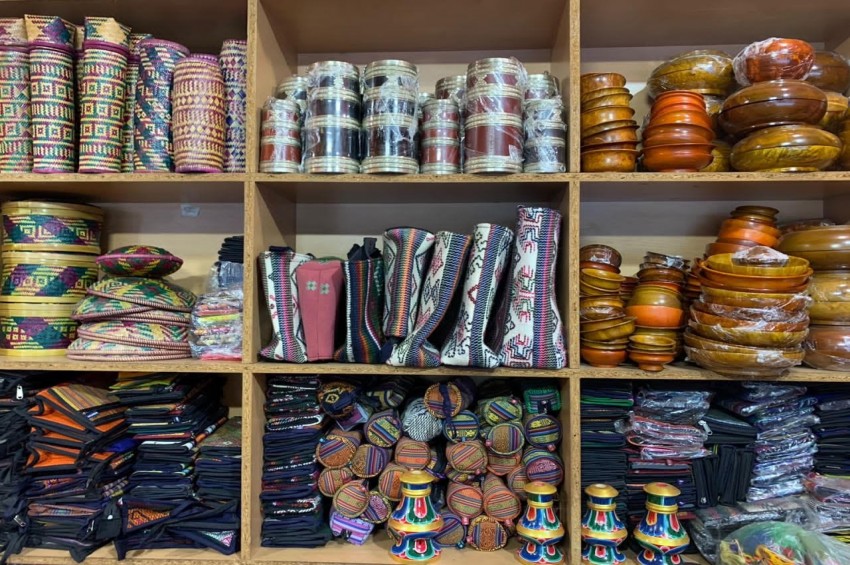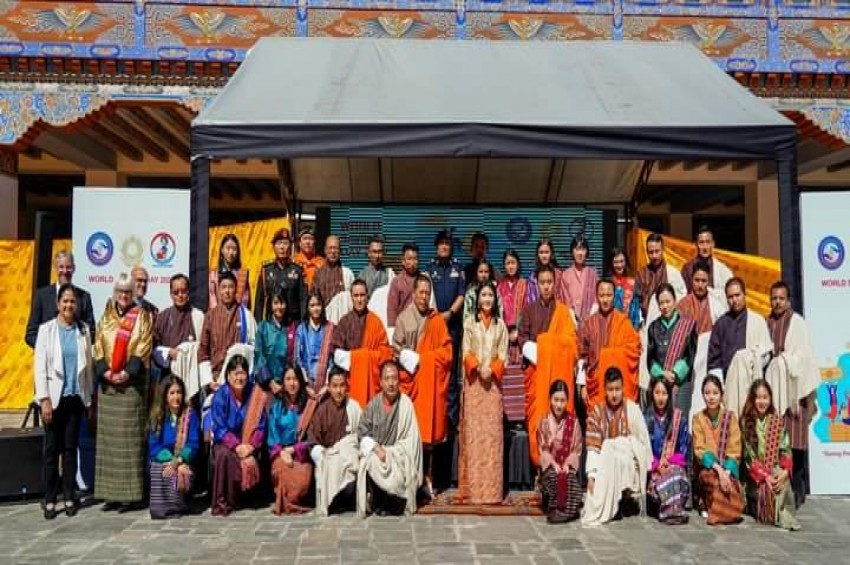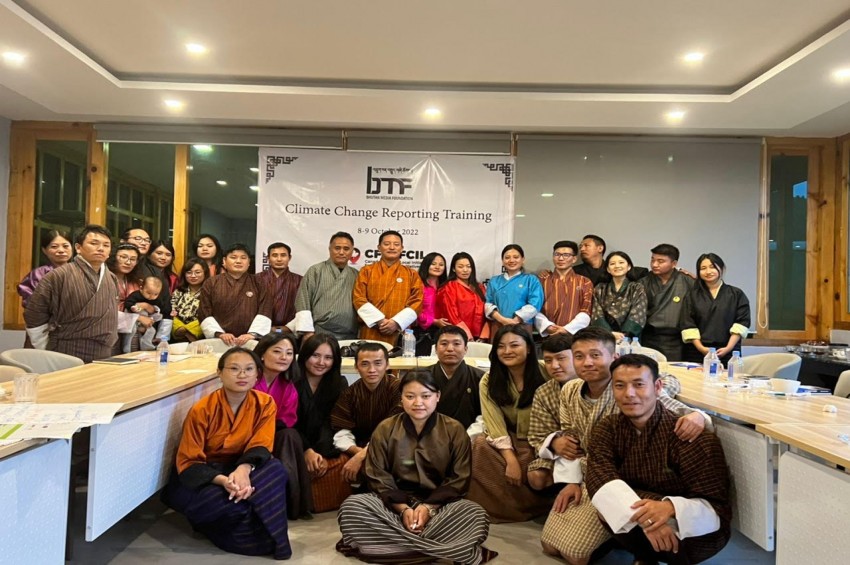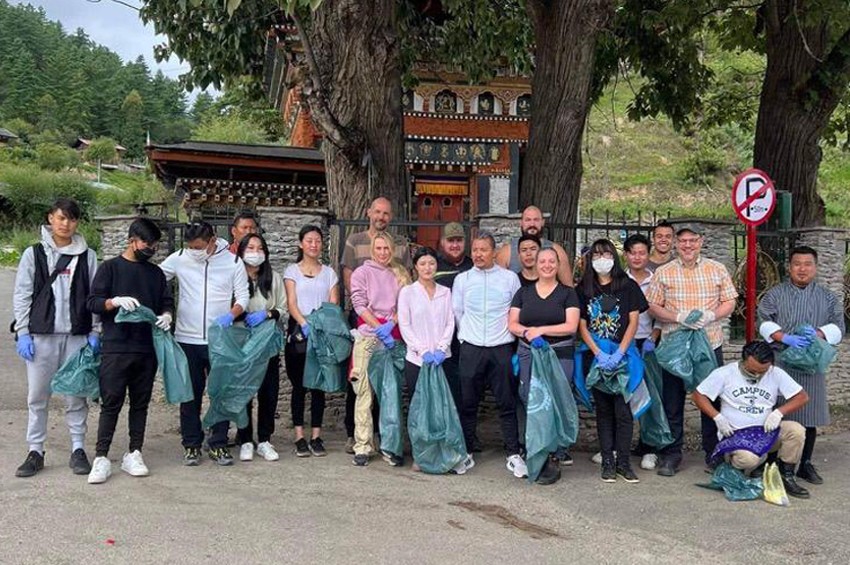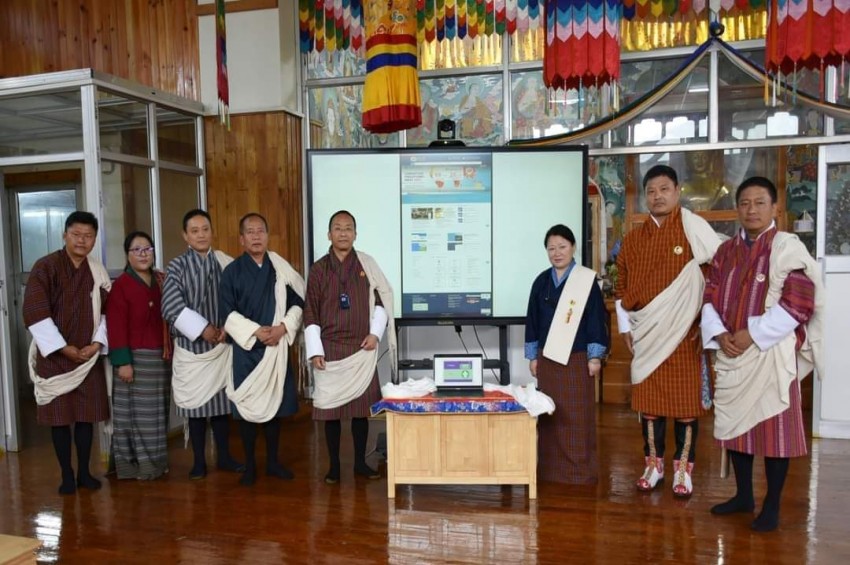Artisans believe their business will pick pace along with the recovery of the tourism sector
More than 80 handicraft stalls along the Chubachu crafts market stretch are yet to pick up the normal business pace with the reopening of the tourism industry last month.
Tshokey Yangden, running Norphel Handicraft in one of the tiny bamboo huts along the stretch shared that lesser visitors purchase the local products.
She started the business in 2008. She said, “In 14 years of running a handicraft stall, this year we could sell the least.”
Comparatively, the handicraft business fell by almost 50 percent. Tshokey said, “I can hardly make between 20 to 30 percent of the income. Previously, I made 50 to 60 percent of our income through handicraft business.”
Tshokey claimed that she earned at least Nu 30,000 a day, but now she could hardly make Nu 1,000 a day. She typically entertains regional tourists who purchase key chains, scarves, caps, and bags. “But these items are rarely sold nowadays. It also depends on the customer’s preference,” she said.
A few left the craft market to try their hands on some other business as the market suffered a major burnt as a ripple effect of tourism closure. However, many rooted for the tourism industry to resume.
“Since we did not have any ideas about other businesses, we rooted for the tourism sector to reopen,” said Tshokey.
Like Tshokey many fears losing their livelihood if the situation continues. With the shrinking number of tourists buying products at the crafts market, the local artisans are facing difficulty to sustain with the amount they earn. There’s a striking contrast in their business before the Covid-19 pandemic hit the country and after the re-opening of the tourism sector with major reformative changes. “There was no question on sustainability of our livelihood with what we earned before the pandemic but today, we can’t state the same,” she added.
“But now we're torn between replacing the products we sold with our little earnings or using them for consumption. If we do use it sustainably, business is difficult, and if we do not, our livelihood is tough,” explained Tshokey.
However, the artisans are hopeful to see more visitors in the coming days. It has just been a month since the tourism sector started from ground zero.
Jigme from Phurba Handicraft said that his daily earnings depend on people who are fond of art. For him, there is not much difference in how his business is run. He said, “The situation was the same before and after the pandemic. We earn around Nu 30,000 to 40,000 if we had clients who appreciated our work. Sometimes we could barely earn more than 5000 with no customers.
Jigme sells a hybrid of traditional and contemporary paintings depending on his client’s taste and preference. Most of his customers are high-end visitors paying US dollars with a handful of Bhutanese customers.
Phurba Handicraft stall is a symbol of a typical Bhutanese family-run business. Jigme’s mother handed down the stall to Jigme’s brother and him. The two brothers started the business in 2015.
The brothers have been depending on their customers to sustain their livelihood for the last seven years. “It’s unpredictable, we have a bumper sale at times and at times it’s difficult to make the ends meet.”
Although Jigme can’t say much about the future of tourism and the handicraft business, he noticed that more art enthusiasts have been visiting the crafts market. “Surprisingly, the number of local customers appreciating authentic arts is increasing not just the high-end tourists.”
Yeshey Choden, Yeshey Tshongkhang is also facing difficulties to sell her products. However, she believes that it’s better to open the stall rather than remain closed.
With the recent reopening of the tourism sector, Yeshey claimed to have earned around Nu 15,000. She said, “Earlier, I earned between Nu 30,000 to 50,000 selling Kuthangs of various sizes.”
Yeshey took over the business from her relative about 2 and a half years ago. And she sells Kuthangs, masks, and bags to equally mix customers from first countries, regional tourists, and local clients.
For Yeshey, he income has dropped after the pandemic but she claimed that with the amount she earned so far, her life is manageable.
Cheney Wangmo, another artisan at the crafts market is pleased with the re-opening of international borders last month. She said, “I am hopeful that our business will pick the pace like before.”
Cheney shared a story of how an Indian couple brightened her face up after they bought a bag worth Nu 1,150 after three consecutive days of no sale. She said, “I even gifted the couple a scarf and told them that they were the first regional guests visiting and purchasing from her stall in three years.”
Before the Covid-19 pandemic, most of her customers were regional tourists often buying scarves and ties as a souvenir for their families and relatives back home. Nowadays, it’s difficult for her with fewer international customers. However, Chey said that the local customers are proving a better clients, particularly those going abroad. “Local customers usually purchase purses, ties, and scarves to gift their friends and families living abroad,” said Cheney.
Ugyen another artisan at the crafts market claimed that the re-opening of tourism has not helped the business as expected. He said, “Sales are still down, lesser visitors are buying the product which is helpful in a small way, but we are hopeful that everything returns to normal.”
However, there are a group of artisans skeptical about their business returning to normal. They claimed that their business is tourist-depended, but with many new policies that the tourism sectors have implemented might impact their business.
Wangmo represents the group. She said, “We are delighted with the re-opening of the tourism sector. At the same time, circumstances have changed drastically. We think the number of tourists visiting Bhutan will drop with the new sustainable development fee (SDF) in place. And the craftsman market will continue to have a slow day.”
Moreover, the Tourism Council of Bhutan (TCB) redeveloped the brand Bhutan. Replacing the destination slogan ‘happiness is a place with a national slogan ‘believe’, it’s expected to change the face of the craftsman market to
Under the brand Bhutan Believe, the handicraft items are expected to get more authentic and local rather than selling some imported goods and leaving the visitors unbelievably surprised.
“Artisans need to believe in themselves that a great change will benefit them in the long run,” said a customer at the crafts market.
More than 80 handicraft stalls along the Chubachu crafts market stretch are yet to pick up the normal business pace with the reopening of the tourism industry last month.
Tshokey Yangden, running Norphel Handicraft in one of the tiny bamboo huts along the stretch shared that lesser visitors purchase the local products.
She started the business in 2008. She said, “In 14 years of running a handicraft stall, this year we could sell the least.”
Comparatively, the handicraft business fell by almost 50 percent. Tshokey said, “I can hardly make between 20 to 30 percent of the income. Previously, I made 50 to 60 percent of our income through handicraft business.”
Tshokey claimed that she earned at least Nu 30,000 a day, but now she could hardly make Nu 1,000 a day. She typically entertains regional tourists who purchase key chains, scarves, caps, and bags. “But these items are rarely sold nowadays. It also depends on the customer’s preference,” she said.
A few left the craft market to try their hands on some other business as the market suffered a major burnt as a ripple effect of tourism closure. However, many rooted for the tourism industry to resume.
“Since we did not have any ideas about other businesses, we rooted for the tourism sector to reopen,” said Tshokey.
Like Tshokey many fears losing their livelihood if the situation continues. With the shrinking number of tourists buying products at the crafts market, the local artisans are facing difficulty to sustain with the amount they earn. There’s a striking contrast in their business before the Covid-19 pandemic hit the country and after the re-opening of the tourism sector with major reformative changes. “There was no question on sustainability of our livelihood with what we earned before the pandemic but today, we can’t state the same,” she added.
“But now we're torn between replacing the products we sold with our little earnings or using them for consumption. If we do use it sustainably, business is difficult, and if we do not, our livelihood is tough,” explained Tshokey.
However, the artisans are hopeful to see more visitors in the coming days. It has just been a month since the tourism sector started from ground zero.
Jigme from Phurba Handicraft said that his daily earnings depend on people who are fond of art. For him, there is not much difference in how his business is run. He said, “The situation was the same before and after the pandemic. We earn around Nu 30,000 to 40,000 if we had clients who appreciated our work. Sometimes we could barely earn more than 5000 with no customers.
Jigme sells a hybrid of traditional and contemporary paintings depending on his client’s taste and preference. Most of his customers are high-end visitors paying US dollars with a handful of Bhutanese customers.
Phurba Handicraft stall is a symbol of a typical Bhutanese family-run business. Jigme’s mother handed down the stall to Jigme’s brother and him. The two brothers started the business in 2015.
The brothers have been depending on their customers to sustain their livelihood for the last seven years. “It’s unpredictable, we have a bumper sale at times and at times it’s difficult to make the ends meet.”
Although Jigme can’t say much about the future of tourism and the handicraft business, he noticed that more art enthusiasts have been visiting the crafts market. “Surprisingly, the number of local customers appreciating authentic arts is increasing not just the high-end tourists.”
Yeshey Choden, Yeshey Tshongkhang is also facing difficulties to sell her products. However, she believes that it’s better to open the stall rather than remain closed.
With the recent reopening of the tourism sector, Yeshey claimed to have earned around Nu 15,000. She said, “Earlier, I earned between Nu 30,000 to 50,000 selling Kuthangs of various sizes.”
Yeshey took over the business from her relative about 2 and a half years ago. And she sells Kuthangs, masks, and bags to equally mix customers from first countries, regional tourists, and local clients.
For Yeshey, he income has dropped after the pandemic but she claimed that with the amount she earned so far, her life is manageable.
Cheney Wangmo, another artisan at the crafts market is pleased with the re-opening of international borders last month. She said, “I am hopeful that our business will pick the pace like before.”
Cheney shared a story of how an Indian couple brightened her face up after they bought a bag worth Nu 1,150 after three consecutive days of no sale. She said, “I even gifted the couple a scarf and told them that they were the first regional guests visiting and purchasing from her stall in three years.”
Before the Covid-19 pandemic, most of her customers were regional tourists often buying scarves and ties as a souvenir for their families and relatives back home. Nowadays, it’s difficult for her with fewer international customers. However, Chey said that the local customers are proving a better clients, particularly those going abroad. “Local customers usually purchase purses, ties, and scarves to gift their friends and families living abroad,” said Cheney.
Ugyen another artisan at the crafts market claimed that the re-opening of tourism has not helped the business as expected. He said, “Sales are still down, lesser visitors are buying the product which is helpful in a small way, but we are hopeful that everything returns to normal.”
However, there are a group of artisans skeptical about their business returning to normal. They claimed that their business is tourist-depended, but with many new policies that the tourism sectors have implemented might impact their business.
Wangmo represents the group. She said, “We are delighted with the re-opening of the tourism sector. At the same time, circumstances have changed drastically. We think the number of tourists visiting Bhutan will drop with the new sustainable development fee (SDF) in place. And the craftsman market will continue to have a slow day.”
Moreover, the Tourism Council of Bhutan (TCB) redeveloped the brand Bhutan. Replacing the destination slogan ‘happiness is a place with a national slogan ‘believe’, it’s expected to change the face of the craftsman market to
Under the brand Bhutan Believe, the handicraft items are expected to get more authentic and local rather than selling some imported goods and leaving the visitors unbelievably surprised.
“Artisans need to believe in themselves that a great change will benefit them in the long run,” said a customer at the crafts market.

